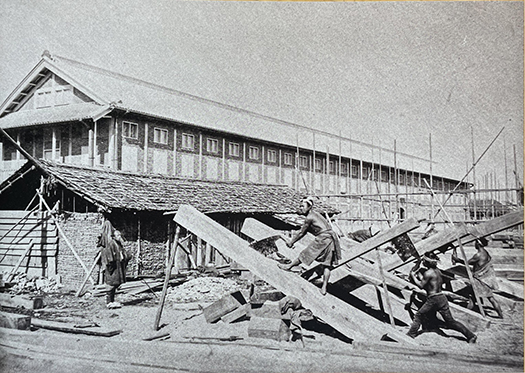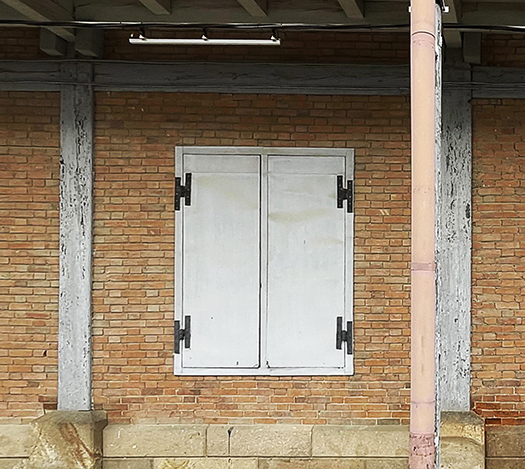


富岡製糸場の参観ではやはり明治5年段階の大規模建築、公共投資としての大型建築のありようが興味深かった。それまでの日本建築は城郭建築が主体であり、その目的性に根ざした技術が伝承されてきた。民間建築は各地域での農家などの建築が主体で、都市では長屋などの集住建築が量的には主流という市場構造だった。
そういう建築界の状況に対して、明治維新という革命は巨大なインパクトを与えた。産業のための建築という新領域が広大に広がっていくという予感で、のちにゼネコンと言われる企業家たちは奮い立っていた。
明治4−5年という時期、さながら「洋造」建築の展示場のように北海道開拓の首府、札幌の街区建設が進められ、同時に寒冷気候に対応した住宅技術研究が旺盛に開始していた。たぶん明治期の国家にとって対ロシアの国防目的からの北海道移民促進と、この「ものづくりニッポン」の創始は両輪として意図され進められた。
上の写真は富岡製糸場の建築風景と、外壁に現れた「木骨レンガ造」の構造素地。そして、伝統木造工法では柱のない大作業空間ができないことから、西洋の木造技術と言える「トラス工法」が導入されて柱のない大空間が可能になった様子。事実として、こうして出来上がった大作業空間は、その後、百年を超えて官営〜民営の全期間、富岡製糸場の経営の土台を支え続けた。普通は業容の拡大に合わせて建て替えなどで対応するのが一般的と言われる中で、ここでは創建時の建築が事業を支え続けたのだ。
フランスの建築技師たちはメートル法に基づいた図面を提示したけれど、日本の大工たちは尺貫法に翻訳させながら柔軟に対応していった。
北海道で官民挙げて「寒冷地対応」の住宅性能を追求進化させている一方で、産業発展の機能性空間という方向に本州以南地域では発展させていった様子が伝わってくる。

建築として特徴的なレンガの表情。明治初年段階では、こうしたレンガは日本建築の伝統にはなかったので、旧来の「瓦製造業」たちが、フランス人技術者の指導を受けながら生産していったのだという。地元の土を焼成させた独特の風合い・色合いには、なにか癒されるものを感じる。「よく来たな、北海道から」と(笑)。
また、つなぎのセメントは入手困難な輸入製品だったので、国内の漆喰が利用された。その構造もまた日本社会の柔軟な「対応力」を見る思い。
木骨の骨組みを現場で木挽きしている大工職人たちの力感にもいかにも「精魂込めているぜ」みたいな心意気を感じさせられる。フランス人たちは「フランス革命と同等」と明治維新を評価していたとされるけれど、150年前ころの先人たちのはるかな叫び声が、こちらの胸奥に響き渡っていた。
English version⬇
Architectural “Innovations” of the Meiji Era: Large-Space Structure of Tomioka Silk Mill – 3
The “truss construction method,” which is not found in traditional Japanese construction methods, made possible a large space with no pillars, and at the same time, the bricks that make up the walls were researched and developed by a tile manufacturer. …
In visiting the Tomioka Silk Mill, it was interesting to see how large-scale construction in the 5th year of Meiji (1872) was carried out as a public investment. Until then, Japanese architecture was mainly castle architecture, and techniques rooted in the purpose of such architecture were handed down from generation to generation. The architecture of the private sector was primarily that of farmhouses and other buildings in each region, while in the cities, row houses and other residential buildings were the mainstream in terms of quantity.
The Meiji Restoration revolution had a huge impact on this situation in the architectural world. Entrepreneurs, who later became known as general contractors, were excited by the prospect of the vast expansion of a new field of architecture for industry.
In the 4th and 5th year of Meiji (1871-1912), the construction of city blocks in Sapporo, the capital of Hokkaido, was underway as if it were an exhibition hall for “Western-style” architecture, and at the same time, research on housing technology for cold climates was vigorously underway. The Meiji period was probably a time when the nation was promoting immigration to Hokkaido for the purpose of national defense against Russia, and the creation of “Monozukuri Nippon,” or “Manufacturing Nippon,” was promoted as a double-edged effort.
The photo above shows an architectural scene of the Tomioka Silk Mill and the “wood-frame brick structure” that appeared on the exterior walls. The photo above shows the “wood-frame brick structure” of the Tomioka Silk Mill and the “truss construction method,” a Western wooden construction technique, which was introduced to create a large working space without pillars, because the traditional wooden construction method could not be used to create a large working space without pillars. As a matter of fact, the large working space thus created continued to support the foundation of the Tomioka Silk Mill’s management for more than 100 years during the entire period of government and private management. While it is said that the factory is usually rebuilt to accommodate the expansion of the business, the architecture of the factory at the time of its foundation continued to support the business.
French architectural engineers presented drawings based on the metric system, but Japanese carpenters flexibly adapted the system by translating it into the shaku-kan system.
While the public and private sectors in Hokkaido were pursuing and evolving “cold-weather” housing performance, the southern Honshu region was developing in the direction of functional space for industrial development.
The look of the bricks is characteristic of the architecture. In the early Meiji period, such bricks were not part of the Japanese architectural tradition, so they were produced by the old “tile makers” under the guidance of French engineers. The unique texture and coloring of the fired local clay is soothing to the senses. I was surprised that they came all the way from Hokkaido,” he said with a laugh.
The cement used to connect the buildings was an imported product that was difficult to obtain, so domestic plaster was used. The structure of the building also reflects the flexible “adaptability” of Japanese society.
The carpenters who were sawing the wooden frame on site also showed a spirit of “we put our hearts and souls into it. It is said that the French regarded the Meiji Restoration as “equivalent to the French Revolution,” but the distant cries of our predecessors around 150 years ago echoed deep in my heart.
Posted on 10月 5th, 2024 by 三木 奎吾
Filed under: 住宅取材&ウラ話







コメントを投稿
「※誹謗中傷や、悪意のある書き込み、営利目的などのコメントを防ぐために、投稿された全てのコメントは一時的に保留されますのでご了承ください。」
You must be logged in to post a comment.